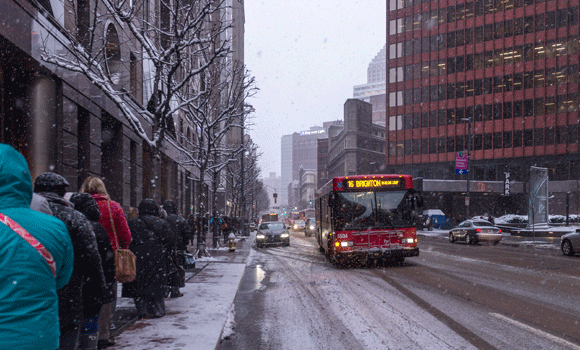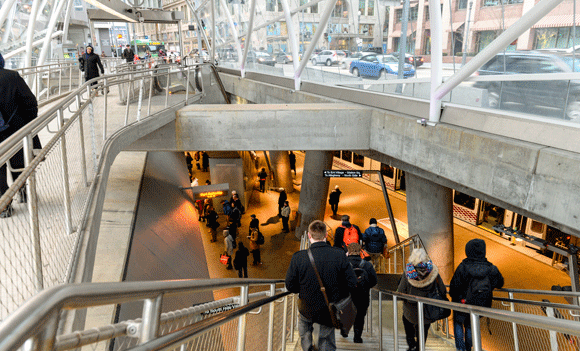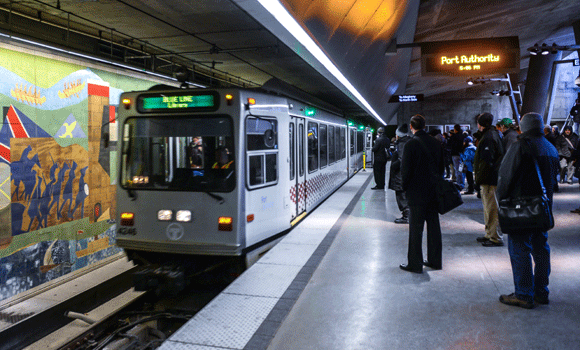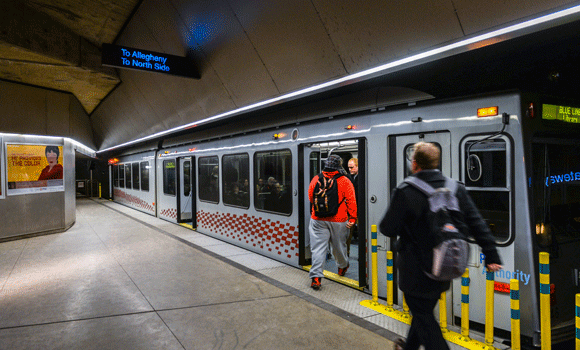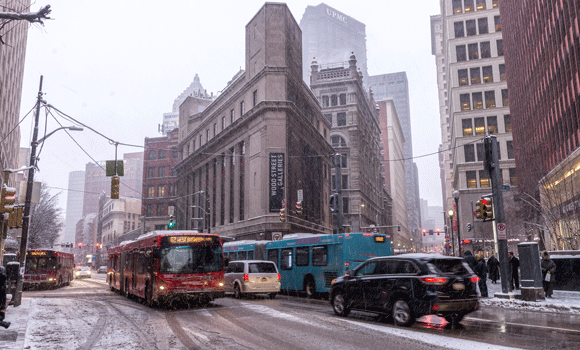On a cold January day, riders at the East Liberty Station on the Martin Luther King Jr. East Busway occupy themselves as they wait for the bus. They chat, read, check their phones — business as usual. What isn't so usual, however, are the newly constructed platforms they're standing on.
The refurbished platforms — which feature better lighting, overhead shelter and a wheelchair-accessible ramp — represent one component of a $130 million revitalization investment known as the East Liberty Transit Center. Partially funded by a $2.3 billion transportation bill signed by former Governor Tom Corbett, the ongoing project, which is set for completion sometime in 2016, includes a pedestrian bridge connecting Ellsworth and Penn avenues, a parking garage, and additional residential and commercial space.
While residents can actually see construction progressing in East Liberty, there are many other innovative, yet less visible ways Steel City thinkers and planners are improving transportation for Pittsburgh residents and Pennsylvania as a whole.
Pennsylvania sees more green
Across the state, people are working behind the scenes to transform a system that, to many industry experts, was long overdue for an update. For Traffic Planning and Design Inc. President Kevin Johnson, the resistance to change reflects the state's cautious approach to new ideas.
"Pennsylvania tends to be very conservative," he hypothesizes. "They want to make sure all the bugs are worked out of everything before they will adopt something."
Johnson will chair the Transportation Transition Team, a group tasked with bringing newly elected Governor Tom Wolf up to speed on existing issues within the transportation field. Johnson, who also served on Corbett's review team and has prepared and managed hundreds of final design plans for state highways and intersections, has witnessed many innovative changes taking place within the statewide infrastructure.
One change he cites is the employment of Rhythm Engineering's InSync Traffic Adaptive Signal System by the Pennsylvania Department of Transportation (PennDOT). As opposed to traditional systems, which use set times to determine when lights change, adaptive traffic signals monitor and self-adjust to variations in traffic volumes. The signals also communicate with one another at multiple intersections to promote more sustained traffic flows.
According to Johnson, the technology has been a great success throughout eastern Pennsylvania, especially in Montgomery Township, which installed around 50 signals as part of upgrades to routes 202 and 309.
"It's amazing now when you get on 309, you'll come off what's known as the 309 Bypass, and you can probably get through the next six or seven intersections at least," explains Johnson. "And that's covering a three- or four-mile distance without ever hitting a red light.”
Johnson adds that the progression of traffic translates into a significant reduction in fuel consumed — around 15 percent, by his count — from not having to wait at lights.
Pittsburgh boasts a comparable technology with Scalable Urban Traffic Control, or Surtrac, an artificial intelligence-based system developed by the Traffic21 Institute at Carnegie Mellon University (CMU). Like adaptive traffic signals, Surtrac, which was deployed at intersections in East Liberty earlier this year, responds in real-time as opposed to working on a fixed-time cycle. While the system operates in a similar manner to PennDOT’s adaptive signals, Traffic 21 Executive Director Stan Caldwell insists that Surtrac is designed for urban grids.
"There are other adaptive signal technologies out there — commercial ones — that work mostly with suburban arterials, where you have a major flow of traffic in one direction or the other," he says. "In morning rush hour, everyone's going one way; in evening rush hour, everyone's going the other way. But take a more complex area like East Liberty where you have traffic coming on Penn, you have traffic coming on Highland, you have traffic coming from all different directions at different times of the day, this system can automatically adapt each light cycle."
Traffic21 was initially funded by the Henry L. Hillman Foundation. The organization aimed to make Pittsburgh a research testing ground and showcase it as a smart city at events such as the 25th annual Intelligent Transportation Society of America, which will convene this June at the David L. Lawrence Convention Center. The program deploys technology such as Surtrac into the field to determine whether it works in a real-world environment.
So far, Surtrac has led to a reduction in travel time by 25 percent, a reduction in wait times by 40 percent, and a 20 percent decrease in emissions. The system will significantly increase its network by next spring, covering 50 major intersections in the East End from Braddock Avenue up through Craig Street.
Follow that bus
Another innovation CMU has invested in is the Tiramisu app, a real-time bus-tracking app developed by a team at the Robotics Institute in 2011. The free application allows smartphone users to update transit information through crowdsourcing, making it easier for riders to determine when buses or light rail vehicles are scheduled to arrive. Though Tiramisu was launched in the Pittsburgh region, the software architecture was designed to work with multiple transit systems.
More specific to the region is Port Authority of Allegheny County's TrueTime. The real-time bus tracking system covers all but six of PAT's 98 bus routes throughout the Hill District, McKeesport, Squirrel Hill and other neighborhoods. While plenty of apps have been developed to address public transportation issues in Pittsburgh and throughout Allegheny County, Port Authority spokesperson Heather Pharo sees TrueTime as fulfilling one major request from PAT riders.
"Real-time tracking information has been something that people have wanted for a very long time in Pittsburgh and Allegheny County," she says. "Certainly it's something that most modern transit agencies have."
While TrueTime has rolled out fairly quickly, another Port Authority program, the ConnectCard, has taken more time to develop. The reusable plastic card was introduced as a convenient and secure fare alternative to paper passes or cash. Users can check their balance and load money onto the card at designated Port Authority retail outlets or at select T-stations.
Pharo explains that converting riders to the ConnectCards has proven a longer process, as the Port Authority needed time to change over their annual, monthly and weekly pass holders.
"It's our goal to have more people use ConnectCard, and I think as we continue to offer more features, the amount of use is going to continue to increase," she adds, explaining plans to offer online account management, single-trip tickets at ConnectCard machines for occasional riders or tourists, and eventually making day or weekend passes available.
Philadelphia is implementing something similar with SEPTA Key, the smart card system for the Southeastern Pennsylvania Transportation Authority. The technology, which launched late last year, is replacing the region's outdated tokens, paper tickets and magnetic-stripe passes with contactless credit cards or SEPTA-issued cards on buses, trollies and high-speed lines.
The SEPTA Key — which will expand to the region's trains by 2016 — is expected to improve various transit issues. And, as Johnson points out, the computerized system will also provide the ability to collect data on ridership; SEPTA can then use it to better serve the public.
"We're losing fares right now because we're physically not able to collect them all on a train," says Johnson, who serves on the SEPTA Board of Directors. "So it's going to increase our revenue. And then we're going to be able to move people through the system faster. And then we'll be able to know where our needs are."
Driving toward change
As many programs continue to roll out, the future of transportation in the state has started to come into focus. Since the 1980s, CMU has worked to develop and promote autonomous or self-driving vehicles. Last June, CMU demonstrated the technology by transporting state Rep. Bill Shuster of the House Transportation and Infrastructure Committee from Cranberry Township to the Pittsburgh Airport in the university’s own autonomous-converted Cadillac SRX. The event once again called attention to the potential benefits of widespread autonomous vehicle use, including more efficient travel, reduced greenhouse gases, and improved safety.
Caldwell believes autonomous vehicles will come to the state, but not all at once. Instead, the technology will come gradually through the addition of more and more automated features, such as parallel parking and brake assist. To that end, CMU has partnered with ride-share giant Uber on a new research lab.
"We see this whole process as continuing on that same path where these features will be slowly integrated into the commercial fleet," explains Caldwell. "We'll look back in 10, or maybe even 20 years and see that, wow, now we have autonomous vehicles."
However funding continues to present a challenge for any new technology. While Corbett’s massive transportation bill has helped move innovative initiatives forward, Johnson explains that an increase of funding at the federal level will need to occur before the state can completely update and modernize its transportation system.
"PennDOT was doing an unbelievable job maintaining the system they had and keeping it going with the budget that they had," he says. "And now they're able to do a great job with things going forward. But we would really be able to add to our capacity and be able to implement a lot of these new technologies faster if the federal government would do a similar transportation bill."

